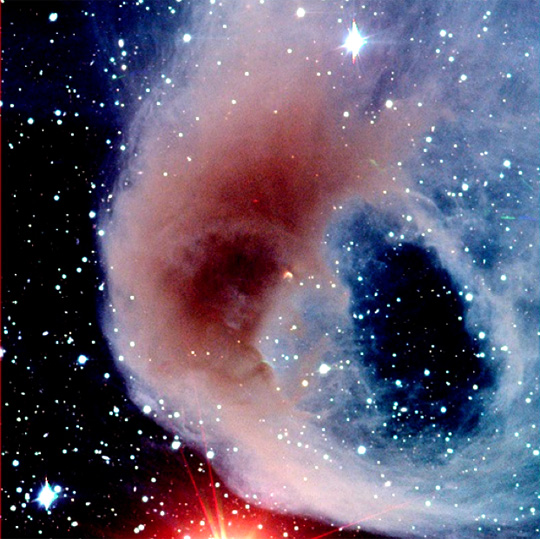The University of Toledo’s partnership with the Discovery Channel Telescope in Arizona has helped launch the UT astronomy program onto a new level. For the first time, a UT graduate student published a significant paper made possible by data collected from observations with the telescope.
The paper on the properties of interstellar dust appears as a cover feature article in the September issue of Astronomy & Astrophysics. The UT research team studied the dust properties present in the Vulture Head nebula, a collection of dust and gas 420 light years from Earth. The team observed the nebula with the Discovery Channel Telescope, a 4.3-meter telescope located south of Flagstaff, overlooking the Verde Valley. It is the fifth largest telescope in the continental United States and one of the most technologically advanced.

In one of the first detailed images of the Vulture Head nebula, the cloud is illuminated by the faint starlight of the Milky Way and couldn’t have been captured in this detail without the power of the Discovery Channel Telescope. Dr. Aditya G. Togi took this photo.
The research team also included Dr. Adolf N. Witt, UT professor emeritus of astronomy, and Demi St. John, an undergraduate student from Murray State University. St. John, selected by the UT Physics and Astronomy Department to join the team, was part of the Research Experiences for Undergraduates program and funded through a National Science Foundation grant. She is in her first year of graduate school at Montana State University.
The team chose to observe the nebula with the Discovery Channel Telescope to test a model developed by French astronomers about the types and properties of dust particles. No one had ever tested those models through observation.
The French model posited that certain dust grains have specific properties. But the astronomers didn’t know for sure what types of dust grains were in the nebula or what size, temperature or density they were, Togi said.
The UT team measured the temperature and mass of the nebula’s dust and found that the dust grains in the cloud closely matched the properties predicted by three dust grain models in the French astronomer’s work. The research confirmed most of the model’s predictions and led the astronomers to new understandings about the dust particles that form stars.
They also learned that the cloud had something called “core shine.” The team knew that in order to scatter the light that creates core shine, some of the dust grains had to be larger than normally encountered in interstellar space. They found that the grains were more complex or “evolved.” They were coated with ice and frozen gases and had grown to about 100 times the volume of a typical interstellar dust grain.
“In order to reach this grain growth, the cloud must be at least a million years old,” Witt said.
Access to the Discovery Channel Telescope was crucial to this research. It’s also a powerful tool when attracting graduate students and young faculty.
“To be truly competitive, to have a first-rate program, you’ve got to have this kind of access to a first-class instrument,” Witt said.
UT is scheduled to host the annual Discovery Channel Telescope partner board meeting Friday and Saturday, Dec. 8 and 9, at the Driscoll Alumni Center. About a dozen representatives from UT, the Lowell Observatory, Boston University, Yale University, the University of Maryland, Northern Arizona University and the University of Texas at Austin will meet to discuss shared governance of the telescope and the best scientific uses of the instrument.
The Discovery Channel Telescope partnership has been a boon to UT astronomers and helped put the astronomy department on the map.
“Our astronomy program at Toledo is on an accelerating path,” said Dr. J.D. Smith, UT professor of astronomy, who is planning the board meeting. “We’re being recognized nationally and internationally, and this partnership is a big part of the reason why.”